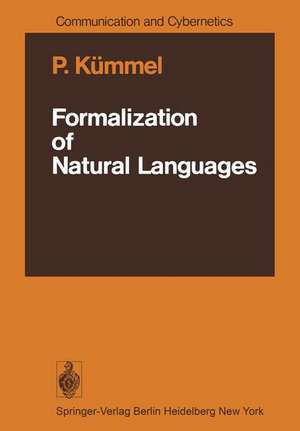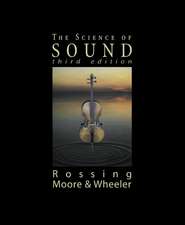Formalization of Natural Languages: Communication and Cybernetics, cartea 15
Autor P. Kümmelen Limba Engleză Paperback – 12 noi 2011
Preț: 639.41 lei
Preț vechi: 752.24 lei
-15% Nou
Puncte Express: 959
Preț estimativ în valută:
122.37€ • 127.42$ • 103.42£
122.37€ • 127.42$ • 103.42£
Carte tipărită la comandă
Livrare economică 10-24 martie
Preluare comenzi: 021 569.72.76
Specificații
ISBN-13: 9783642666674
ISBN-10: 3642666671
Pagini: 240
Ilustrații: X, 226 p.
Dimensiuni: 170 x 244 x 13 mm
Greutate: 0.39 kg
Ediția:Softcover reprint of the original 1st ed. 1979
Editura: Springer Berlin, Heidelberg
Colecția Springer
Seria Communication and Cybernetics
Locul publicării:Berlin, Heidelberg, Germany
ISBN-10: 3642666671
Pagini: 240
Ilustrații: X, 226 p.
Dimensiuni: 170 x 244 x 13 mm
Greutate: 0.39 kg
Ediția:Softcover reprint of the original 1st ed. 1979
Editura: Springer Berlin, Heidelberg
Colecția Springer
Seria Communication and Cybernetics
Locul publicării:Berlin, Heidelberg, Germany
Public țintă
ResearchCuprins
1. Introduction.- 1.1 Motivations for Formalizing Natural Languages.- 1.2 Essential Results of Formalizing Natural Languages.- 1.3 Projected Dimensions and Definition of Formalizing Natural Languages.- 1.4 Demarcation Between Natural and Artificial Languages.- 1.5 Limits of Conventional Formalizing Efforts Due to One-Sided References to Languages with Agglutinated Morphologies.- 1.6 New Formalization Approach by Emphasizing the Utilization of Natural Languages with Isolated Morphologies.- 2. Historical Survey on Formalization Efforts of Natural Languages.- 2.1 Conventional Formalizations of Morphology.- 2.2 Conventional Formalizations of Syntax.- 2.3 Conventional Formalizations of Semantics.- 2.4 Formalization Results of Natural Logic.- 2.5 Formalization Results by Basic English.- 2.6 Esperanto, A Formalization Product of Artificial Character.- 2.7 Conventional Information Theory.- 2.8 Corpus Restrictions.- 2.9 Historical Survey of Conventional Efforts to Formalize Natural Languages.- 3. Formalizing Stimuli by Understanding Brain Functions in Living Organisms.- 3.1 Anatomy of Neurons and Organic Memory Structures.- 3.2 Memory Functions of Neuronal Links.- 3.3 Research in Neurolinguistics.- 3.4 Summary.- 4. Analyses of Natural Language Morphology.- 4.1 Permanent Visual Expressions.- 4.2 Permanent Visual Expressions with Acute Character.- 4.3 Acute Visual Expressions.- 4.4 Morphological Identities Between Permanent and Acute Visual Expressions.- 4.5 Phonographical Systems.- 4.6 Auditive Expressions.- 4.7 Possible Expression Units for the Tactile, Olfactoric, and Gustile Perception.- 4.8 Summary.- 5. Synthesis and Formalization of Natural Language Morphology.- 5.1 Formalization of Permanent Visual Expression Morphologies.- 5.2 Formalization of Acute Visual Expressions.- 5.3 Formalization of Acute Auditive Expressions.- 5.4 Morphology Universals of Permanent Visual Expressions.- 5.5 Morphology Universals of Acute Expressions.- 5.6 Algorithm of Formalized Morphology (AFM).- 5.7 Summary.- 6. Analyses of Natural Language Syntax.- 6.1 Function Analyses of One Expression Unit.- 6.2 Function Analyses by the Presyntactical Sign Coordinates.- 6.3 Biao-Ratio, Expression Quotient of Sign Content.- 6.4 Biao-Ratio, A Criterion for the Three Expression Categories.- 6.5 Content Definition of the Meaning Sign.- 6.6 Meaning Words, Syntax Particles, Syntagms.- 6.7 Function Analyses of Syntagms.- 6.8 Syntax Universals.- 6.9 Summary.- 7. Synthesis and Formalization of Natural Language Syntax.- 7.1 Standardization Tendencies of Coded Expressions Towards a Biao-Ratio 1.- 7.2 Full Biao-Function.- 7.3 Function Formalization of Coded Expressions.- 7.4 Phenomenon of the Chain-Stitch Method.- 7.5 Graded Syntax Universals.- 7.6 Content-Dependent Context Sensitivity.- 7.7 Summary.- 8. Analyses of Natural Language Content.- 8.1 Newly Born Content Units and Their Classification.- 8.2 Classification Systems of Expressions and Their Content.- 8.3 Analyses of Concreta.- 8.4 Analyses of Abstracta.- 8.5 Summary.- 9. Syntheses and Formalization of Natural Language Content.- 9.1 Vertical Associations of a Deuter.- 9.2 Vectorial Continuity and Vertical Associations in a Componential Inventory.- 9.3 Disposal of One Meaning as a Vertex in a Deuter-Disc.- 9.4 Horizontal Associations of Meanings.- 9.5 The Deuter-Sphere to Represent Vertical and Horizontal Associations of a Content Thesaurus Three Dimensionally.- 9.6 Human-, Individual-, and Partial-Content Thesauri.- 9.7 The Six Subcriteria of One Deuter.- 9.8 Definition of One Deuter Representing the Content Unit of Natural Languages.- 9.9 Summary.- 10. Application of Natural Language Formalizations.- 10.1 Associative Functions in the Deuter-Sphere to Simulate Human Thinking.- 10.2 Associative Functions in the Deuter-Sphere to Establish Fundamental Definition Patterns of Content.- 10.3 Associative Functions in the Deuter-Sphere to Establish Fundamental Classification Rules of Newly Born Meanings.- 10.4 Priority Determination of Research Projects.- 10.5 Fundamental Deuter-Sphere Functions to Conceive Relational Data-Bank Models for Computer Software Concepts.- 10.6 Computer Hardware Realizations of Associative and Analog Memories Based on Deuter-Sphere Functions Including AFG Procedures.- 10.7 Summary.- References.- Author and Subject Index.































